Are you a Quiet Speculation member?
If not, now is a perfect time to join up! Our powerful tools, breaking-news analysis, and exclusive Discord channel will make sure you stay up to date and ahead of the curve.
Last week, we began our discussion on the Theory of Context by examining the principles of interaction that drive individual card playability. From there, we examined the Context of Modern by grouping and analyzing archetypes on a broad level, focusing particularly on the pressures each macro-archetype places on the format as a whole. This week, we’re going to refine our analysis by looking at this concept in greater detail on an individual card level. We’ll end with a review of the most common constraints in Modern, and how we as players and deckbuilders can apply this information to our games and brews. Let’s get to it!
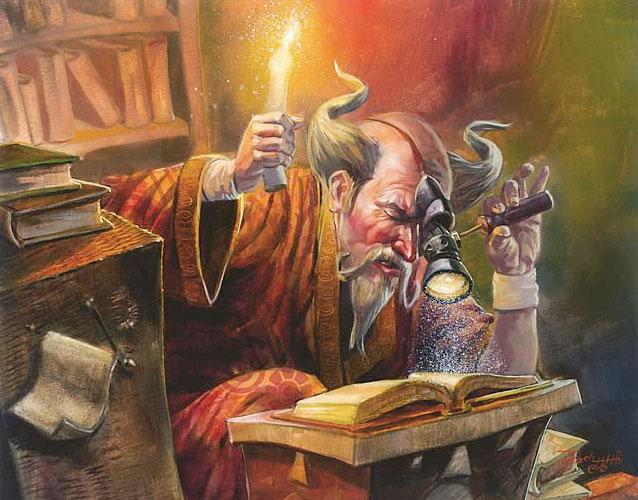
What Makes A Card?
 Why does Loxodon Smiter see play, while Brimaz, King of Oreskos does not? Why isn’t Bloodghast the best creature in Magic? Is Jace, Vryn's Prodigy excellent in Modern, or terrible? While I’m sure we could argue both sides to each of these questions forever (as both sides have valid points), at their core the answers to these questions rely on a two-fold principle. First, every card in Magic exists in a perpetual state of context where its inherent value increases and decreases based on a myriad of environmental factors. Second, while outliers like archetype-specific hate-cards and combo pieces that ignore the normal rules of Magic also exist, what makes a card “playable” is, for the most part, the summation of its variable characteristics. I know that’s a mouthful, and I can see our editor David shaking his fists at me now, [Editor's Note: Of course I am!] so let’s break that down:
Why does Loxodon Smiter see play, while Brimaz, King of Oreskos does not? Why isn’t Bloodghast the best creature in Magic? Is Jace, Vryn's Prodigy excellent in Modern, or terrible? While I’m sure we could argue both sides to each of these questions forever (as both sides have valid points), at their core the answers to these questions rely on a two-fold principle. First, every card in Magic exists in a perpetual state of context where its inherent value increases and decreases based on a myriad of environmental factors. Second, while outliers like archetype-specific hate-cards and combo pieces that ignore the normal rules of Magic also exist, what makes a card “playable” is, for the most part, the summation of its variable characteristics. I know that’s a mouthful, and I can see our editor David shaking his fists at me now, [Editor's Note: Of course I am!] so let’s break that down:
[wp_ad_camp_1]
Context
Environmental factors often break the “Magic Principle Pillars” of mana/card/board advantage, so we’ll start with them first. Why do Rending Volley and Combust see play when Path to Exile or Terminate are so much “better”?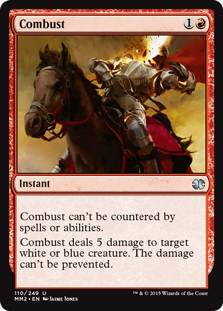 We all know the answer, but I doubt we’ve really stopped and broken it down before. Behold, the narrow argument: Combust only hits white and blue creatures with five toughness or less, while Terminate hits everything! The “counter” to this argument is that Terminate can in fact be countered, while Combust cannot. Disregarding everything we know about Modern, on the surface this seems like a pretty uneven comparison. Terminate hitting five colors of creatures while Combust hits only two more than makes up for the fact that Terminate can be countered and has a more restrictive mana cost. But, once we evaluate Context and see Splinter Twin as a tier 1 archetype in the metagame the picture becomes clearer. In fact, an uncounterable removal spell is probably the absolute best thing we could use to fight Splinter Twin, as their primary strategy revolves around protecting a blue creature with countermagic.
We all know the answer, but I doubt we’ve really stopped and broken it down before. Behold, the narrow argument: Combust only hits white and blue creatures with five toughness or less, while Terminate hits everything! The “counter” to this argument is that Terminate can in fact be countered, while Combust cannot. Disregarding everything we know about Modern, on the surface this seems like a pretty uneven comparison. Terminate hitting five colors of creatures while Combust hits only two more than makes up for the fact that Terminate can be countered and has a more restrictive mana cost. But, once we evaluate Context and see Splinter Twin as a tier 1 archetype in the metagame the picture becomes clearer. In fact, an uncounterable removal spell is probably the absolute best thing we could use to fight Splinter Twin, as their primary strategy revolves around protecting a blue creature with countermagic.
That example was easy. Sideboards are for narrow answers to specific archetypes: that’s the point, right? Again, it depends. Who’s to say whether Kitchen Finks or Feed the Clan is a better choice for our sideboard? Both are great against Burn, but what if Burn didn’t even exist? Which would you rather have against Affinity? How about Grixis Control? Burn does exist, however, along with the rest of those decks, and we haven’t even begun to talk about the composition of our own deck! Mana creatures lie on the opposite side of the pendulum from a plethora of ferocious options, and the vast array of possibilities in between can result in some serious Tug-Of-War. Again, we can apply the same Terminate/Combust exercise here, this time manipulating the variables to line up with the questions we’re asking.
Characteristics
Ah, the measurables. Like the NFL Combine, we can mercilessly reduce living, breathing entities with souls and dreams and feelings into meaningless spreadsheets of statistics.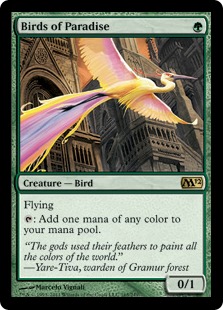 Oh, you never thought of Magic cards that way? Just remember that the Llanowar Elves have feelings too, and are tired of being compared to Birds of Paradise. Here we’re looking at the fundamental principles of Magic and how we can apply them to Magic cards. Lingering Souls nets us four creatures for five mana, while Spectral Procession offers us three for three. Which do you choose? We all know the answer, but again; the reasons tell us something. The ability to flashback for extra value later, its synergy with Liliana of the Veil, along with its resiliency against counterspells, all combine to make Lingering Souls the “better card” assuming we have access to black mana. But how do you compare Voice of Resurgence to Qasali Pridemage? Or Ancient Stirrings to Peer Through Depths? How do we evaluate cards that don’t have direct comparisons, like Shriekmaw or Slaughter Pact or Domri Rade? If only there was a baseline we could use for reference…
Oh, you never thought of Magic cards that way? Just remember that the Llanowar Elves have feelings too, and are tired of being compared to Birds of Paradise. Here we’re looking at the fundamental principles of Magic and how we can apply them to Magic cards. Lingering Souls nets us four creatures for five mana, while Spectral Procession offers us three for three. Which do you choose? We all know the answer, but again; the reasons tell us something. The ability to flashback for extra value later, its synergy with Liliana of the Veil, along with its resiliency against counterspells, all combine to make Lingering Souls the “better card” assuming we have access to black mana. But how do you compare Voice of Resurgence to Qasali Pridemage? Or Ancient Stirrings to Peer Through Depths? How do we evaluate cards that don’t have direct comparisons, like Shriekmaw or Slaughter Pact or Domri Rade? If only there was a baseline we could use for reference…
The Baseline
Noble Hierarch, Lightning Bolt, Serum Visions, Thoughtseize, Path to Exile
Way back when I was a wee lad (or, you know, June) the first article I wrote for Nexus dealt with the principle of Mana as a Resource. Above are (give or take) the best things you can be doing for each color of Magic at one mana. Now Ancient Stirrings I’m sure feels differently, as does Goblin Guide, Thought Scour, and Condemn, and on and on we go. The point is that (and pardon me if I borrow from wee me): these highly efficient spells establish the baseline for what we “should” be spending.
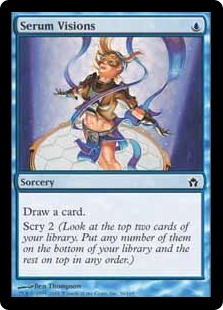 Lightning Bolt is the baseline for removal/burn in red because it has the best rate compared to everything else. Should Lightning Bolt be banned, Pillar of Flame might become the best red one drop Burn spell of choice, similar to how Serum Visions is the “best of the rest” left in the wake of Ponder's and Preordain’s exodus. This is important, because every new card printed both affects and is affected by this principle. Were we to start seeing 4/4’s for G, or two damage + scry 2 for R we might see a paradigm shift, which would result in cascading changes further down the line. When evaluating new cards for Modern, or really just new cards for a deck, keep this list in mind, both as a reality check and a baseline for comparison.
Lightning Bolt is the baseline for removal/burn in red because it has the best rate compared to everything else. Should Lightning Bolt be banned, Pillar of Flame might become the best red one drop Burn spell of choice, similar to how Serum Visions is the “best of the rest” left in the wake of Ponder's and Preordain’s exodus. This is important, because every new card printed both affects and is affected by this principle. Were we to start seeing 4/4’s for G, or two damage + scry 2 for R we might see a paradigm shift, which would result in cascading changes further down the line. When evaluating new cards for Modern, or really just new cards for a deck, keep this list in mind, both as a reality check and a baseline for comparison.
Semi-recently, Anticipate enjoyed some conversation regarding its possible Modern playability, and was tried out a few times but eventually died off: two mana is just “too much” when compared to the baseline. Wait, but isn’t Anticipate played in Scapeshift?! Indeed, some Scapeshift lists run Anticipate instead of (or alongside) Serum Visions and Peer Through Depths. Should we question our evaluation of Anticipate in Modern then? Possibly, but the real lesson to learn here is that measurables alone don’t paint the full picture, as both Anticipate and Drew Brees and Tom Brady can attest. Magic-NFL crossover accomplished! *drops mic*
Why You Hatin’?
Once a bright eyed NFL Prospect/new Magic card/deck makes it through the Combine/Baseline test it faces a new obstacle: navigating the hate. For example:
"U/B Tezzeret, Shota Yasooka - Grand Prix Kobe 2014"
What happened to this deck and Tezzeret? His future was looking bright, but a combination of Ancient Grudge/Stony Silence/not drawing Tezzeret, Agent of Bolas often enough sealed his doom and relegated him to Couch Potato status. Like Pro Bowl linebackers bearing down on a rookie quarterback, here’s a laundry list covering most of the punishing hate cards in the format:
Stony Silence
Played primarily for its power against Affinity, decks like Tron, Lantern Control and the aforementioned U/B Tezzeret all take “splash damage” from its near-ubiquitous presence in white sideboards. As a result, we see Affinity and Lantern Control playing Thoughtseize and Abrupt Decay to fight back, which both incidentally hurt Tezzeret and Swords decks (one of many reasons why Swords decks aren’t seen in Modern).
Blood Moon
 Easily the most significant pressure in the format after Stony Silence, Blood Moon actually isn’t seen that much, mainly because the mere threat of it is often enough to keep irrational manabases at home. Jund splashing Lingering Souls, Jeskai Control splashing black for good cards, even Four/Five Color Gifts decks (like the one I played in my video series last week!) are kept in check by this ominous threat lurking in the shadows. This doesn’t even speak to the Tron and Amulet decks which are both punished by this card. The resulting arms race of powerful deck vs. hate vs. tech to sidestep hate is one of the most interesting aspects of Magic to me, and if you dig into results you can see examples of this every week. (One particular example that comes to mind is Amulet Bloom players incorporating Chromatic Lantern to fight Blood Moon at GP Charlotte when Blood Moon was everywhere).
Easily the most significant pressure in the format after Stony Silence, Blood Moon actually isn’t seen that much, mainly because the mere threat of it is often enough to keep irrational manabases at home. Jund splashing Lingering Souls, Jeskai Control splashing black for good cards, even Four/Five Color Gifts decks (like the one I played in my video series last week!) are kept in check by this ominous threat lurking in the shadows. This doesn’t even speak to the Tron and Amulet decks which are both punished by this card. The resulting arms race of powerful deck vs. hate vs. tech to sidestep hate is one of the most interesting aspects of Magic to me, and if you dig into results you can see examples of this every week. (One particular example that comes to mind is Amulet Bloom players incorporating Chromatic Lantern to fight Blood Moon at GP Charlotte when Blood Moon was everywhere).
Choke
This one isn’t seen that often, but is always devastating when it shows up (at least when my opponents play it against me). Seriously, there’s nothing worse than Jund going discard spell into discard spell into Choke when I’m on Grixis Control. I’m including it here primarily to complain, but also to remind my readers that everyone hates blue, and it actually is easy being green.
Relic of Progenitus
When it comes to graveyard hate, pick your poison. WoTC got a little gun-shy after Dredge, so in Modern we have Relic, Grafdigger's Cage, Leyline of the Void, Rest in Peace, Nihil Spellbomb, and on and on it goes. This keeps Life from the Loam, along with Gifts Ungiven and numerous synergies like delve, flashback and enter the graveyard abilities, in check.
Lightning Bolt
Wait, wasn’t Lightning Bolt a baseline? Yep, and it’s a hate card too. Almost every creature played in Modern for more than one mana either interacts favorably with Lightning Bolt or ignores it entirely. Voice of Resurgence nets a token, Snapcaster Mage nets a 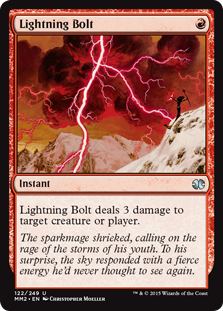 full card, Tarmogoyf is just bigger. The cards that do die to it are “worth it”. Dark Confidant, Jace, Vryn's Prodigy, Ezuri, Renegade Leader. Strategies like Merfolk/Mono White know they can't play around it, so they just flood the board and fight Bolt through sheer numbers or Kira, Great Glass-Spinner and Restoration Angel. The give and take that comes from Lightning Bolt being “the best” can have a few interesting effects. For one, Lightning Bolt forces decks to either work to dodge it by moving up the curve, or moving far enough down the curve that everything does to it but one-for-one damage based removal isn’t enough (Burn/Infect/Affinity). Two, if everyone is relying on Lightning Bolt, then that can be exploited. Kor Firewalker, Deceiver Exarch, and Tasigur, the Golden Fang all punish an opponent relying on Lightning Bolt to trade.
full card, Tarmogoyf is just bigger. The cards that do die to it are “worth it”. Dark Confidant, Jace, Vryn's Prodigy, Ezuri, Renegade Leader. Strategies like Merfolk/Mono White know they can't play around it, so they just flood the board and fight Bolt through sheer numbers or Kira, Great Glass-Spinner and Restoration Angel. The give and take that comes from Lightning Bolt being “the best” can have a few interesting effects. For one, Lightning Bolt forces decks to either work to dodge it by moving up the curve, or moving far enough down the curve that everything does to it but one-for-one damage based removal isn’t enough (Burn/Infect/Affinity). Two, if everyone is relying on Lightning Bolt, then that can be exploited. Kor Firewalker, Deceiver Exarch, and Tasigur, the Golden Fang all punish an opponent relying on Lightning Bolt to trade.
Tarmogoyf
What Lightning Bolt does for removal, Tarmogoyf does for creatures. Loxodon Smiter looks downright embarrassing next to it when the abilities don’t matter. Gurmag Angler often is just trying to be Like Mike, and other creatures decks have to contend with fighting through the biggest bully on the block. When even Blue splashes for the best creature ever printed, you know there’s a problem.
Thoughtseize
Finally, we come to the fun police. Thoughtseize doesn’t care who you are; if you are doing cool things, he will ruin your day. Another culprit to the death of U/B Tezzeret, Thoughtseize is a necessary evil in a format full of powerful, wildly variable strategies pushed to the maximum. Without a catchall form of interaction (or non-interaction, depending on how you feel about the subject) we would probably see Combo Winter all year long.
Conclusion
Whether you are brewing, prepping for an event, picking up a new deck or going over spoilers, understanding Context and how it relates to Modern will go a long way towards aiding your Magic progression. It’s possible most of what we discussed today was review for some, but I’ve found that even systematically outlining what I know helps me determine what I don’t know. One of my studio professor’s favorite lines (as he’s standing over my dejected, depleted body in a pile on the floor) is: better to know what you don’t know, than not know what you do know! When you figure that one out, tell me.
Thanks for reading, and I’ll see you guys next week!
Trevor Holmes
The_Architect on MTGO
Twitch.tv/Architect_Gaming
Twitter.com/7he4rchitect





Liked the content here as separate pieces of observation, but it really doesn’t feel coherent… jumping from combust to tezzeret to tarmogoyf to stony silence to birds of paradise leaves me wondering what exactly you’re trying to tell me about the format.
was it that a good deck or card can be killed off as collateral damage?
was it that new cards have to do more “output-per-mana” than old ones to see play?
was it that we can play hate-card-vulnerable decks if we “next level” the hate card?
I’m not sure. But I think its relevant to point out that grixis control can k-command a relic, or spell snare a rest in peace, but realistically can’t beat a t0 leyline of the void – the deck still exists because there aren’t enough competitive decks that can or want to pack leylines in their board.
Similarly the age of leyline of sanctity has pretty much come and gone (if it was ever real) as burn moves on to more creatures and spells that bypass leyline – that makes it a good time for 8rack – or does it, since kolagan’s command puts people on maindeck 2-for-1 artifact hate that incidentally also fights rack effects?
I’m not totally sure what the msg here was so not sure if those observations have any relevance but they might ;p
So basically Jund plays the most punishing cards in the format. Aside from stony silence. Also help me out here, trying to understand lets say affinity vs creeping corrotion and/or stony silence. Why do we still see affinity winning tournys or being a top tier deck and not Gifts against graveyard hate. Is it because of consistency? Resilience? or something else?
There’s that thing when game is 20 years old and the format we play isn’t young either. So when we see grave strategies prevail, there obviously is a hate around or just bannings if it’s not enough to hold them back. That is for every other thing you would bring to the table. Going rogue works in this situation only if you are on small scene where you could expect certain decks to show up. On a big one you get hit by said collateral damage just because right sideboard is which hits all the possibilities. Oddly enough, 15 slots are often capable of doing so.
So where do we go from this point? I don’t know, but it seems like modern still rewards linear decks the most with Affinity on top of the format right now.